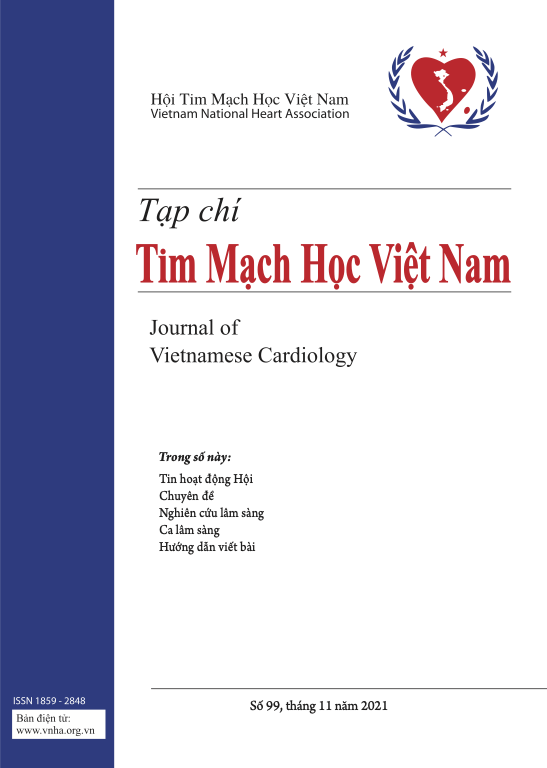Kết quả can thiệp nội mạch điều trị hẹp mạch máu ngoại biên do xơ vữa tại Bệnh viện Đa khoa tỉnh Đồng Nai
DOI:
https://doi.org/10.58354/jvc.106.2023.674Từ khóa:
bệnh mạch máu do xơ vữa, can thiệp nội mạchTóm tắt
Mở đầu: Bệnh lý động mạch ngoại biên là bệnh lý mạn tính, diễn biến lâu dài và gây ra nguy cơ tàn phế nếu không điều trị kịp thời. Các liệu pháp điều trị bao gồm phẫu thuật và can thiệp nội mạch, can thiệp nội mạch ngày càng phát triển hơn. Can thiệp nội mạch ít xâm lấn, có kết quả sớm và kết quả trung hạn tốt
Đối tượng – Phương pháp nghiên cứu: Báo cáo 58 ca bệnh nhân được chẩn đoán bệnh mạch động mạch ngoại biên được can thiệp nội mạch tại bệnh viện đa khoa Đồng Nai trong thời gian từ tháng 04/2021 đến tháng 04/2023.
Kết quả: Có 58 trường hợp được can thiệp nội mạch điều trị bệnh mạch máu ngoại biên tại Bệnh viện Đa khoa Đồng Nai. Trong đó, hẹp hoặc tắc mạn tính động mạch đùi nông chiếm 60,3% các trường hợp, các trường hợp khác bao gồm hẹp động mạch dưới đòn (8,6%), hẹp động mạch chậu chung (15,6%), hẹp động mạch dưới gối (12,1%). Kết quả can thiệp bước đầu tốt, không có tai biến và biến chứng nặng xảy ra, tỉ lệ thông thương mạch máu sớm là 96,6%, lành mỏm cụt 96,6%, tỉ lệ đặt stent là 67,2%, 2 trường hợp chuyển mổ hở vì can thiệp thất bại. 2 trường hợp đoạn chi đến 1/3 trên cẳng chân, 6 trường hợp đoạn chi đến khớp Lisfranc và 19 trường hợp cần cắt ngón. Không có trường hợp nào phải can thiệp lại trong giai đoạn ngắn hạn
Kết luận: Kết quả can thiệp nội mạch điều trị hẹp mạch máu ngoại biên do xơ vữa tại Bệnh viện Đa khoa Đồng Nai khá tốt, giúp cung cấp thêm lựa chọn điều trị cho những bệnh nhân có nguy cơ phẫu thuật cao và hình thành điều trị đội nhóm trong xử lý bệnh tim mạch, một xu hướng tất yếu trong tương lai.
Tài liệu tham khảo
Gerhard-Herman MD, Gornik HL, Barrett C, Barshes NR, Corriere MA, Drachman DE, et al. 2016 AHA/ACC Guideline on the Management of Patients With Lower Extremity Peripheral Artery Disease: Executive Summary: A Report of the American College of Cardiology/American Heart Association Task Force on Clinical Practice Guidelines. Circulation. 2017;135(12):e686-e725.
![]()
Thukkani AK, Kinlay S. Endovascular intervention for peripheral artery disease. Circ Res. 2015;116(9):1599-613.
![]()
Aboyans V, Ricco JB, Bartelink MEL, Bjorck M, Brodmann M, Cohnert T, et al. 2017 ESC Guidelines on the Diagnosis and Treatment of Peripheral Arterial Diseases, in collaboration with the European Society for Vascular Surgery (ESVS): Document covering atherosclerotic disease of extracranial carotid and vertebral, mesenteric, renal, upper and lower extremity arteriesEndorsed by: the European Stroke Organization (ESO)The Task Force for the Diagnosis and Treatment of Peripheral Arterial Diseases of the European Society of Cardiology (ESC) and of the European Society for Vascular Surgery (ESVS). Eur Heart J. 2018;39(9):763-816.
![]()
Sixt S, Krankenberg H, Mohrle C, Kaspar M, Tubler T, Rastan A, et al. Endovascular treatment for extensive aortoiliac artery reconstruction: a single-center experience based on 1712 interventions. J Endovasc Ther. 2013;20(1):64-73.
![]()
Kuntz S, Lejay A, Chakfe N. Subintimal Angioplasty in the Superficial Femoral Artery: A Real Long Term Option Demonstrated by Histology. EJVES Vasc Forum. 2021;52:49-50.
![]()
Iida O, Urasawa K, Komura Y, Soga Y, Inoue N, Hara H, et al. Self-Expanding Nitinol Stent vs Percutaneous Transluminal Angioplasty in the Treatment of Femoropopliteal Lesions: 3-Year Data From the SM-01 Trial. J Endovasc Ther. 2019;26(2):158-67.
![]()
Warner CJ, Greaves SW, Larson RJ, Stone DH, Powell RJ, Walsh DB, et al. Cilostazol is associated with improved outcomes after peripheral endovascular interventions. J Vasc Surg. 2014;59(6):1607-14.
![]()
Giannopoulos S, Lyden SP, Bisdas T, Micari A, Parikh SA, Jaff MR, et al. Endovascular Intervention for the Treatment of Trans-Atlantic Inter-Society Consensus (TASC) D Femoropopliteal Lesions: A Systematic Review and Meta-Analysis. Cardiovasc Revasc Med. 2021;22:52-65.
![]()
Grenville JL, Tan KT, Moshonov H, Rajan DK. Endovascular first strategy for de novo TransAtlantic Inter-Society Consensus C and D femoro-popliteal disease: mid-term outcomes from a single tertiary referral center. Vascular. 2015;23(1):31-40.
![]()
Joo HJ, Jang DH, Yu CW, Choi YJ, Park J, Lee HJ, et al. Efficacy and safety of endovascular treatment for femoropopliteal lesions of TASC II type C and D compared with TASC II type A and B in Korea. Vascular. 2017;25(4):351-8.
![]()
Golledge J, Drovandi A, Velu R, Moxon J. Cohort study examining the relationship between remoteness and requirement for surgery to treat peripheral artery disease at a tertiary hospital in North Queensland. Aust J Rural Health. 2021;29(4):512-20.
![]()








